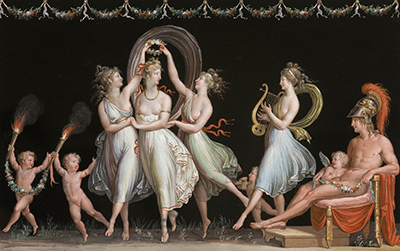Here we discover one of the more complex figurative paintings produced by Antonio Canova, in a career which was generally more focused upon sculpture. He was highly accomplished as a painter, however, and in this example was using the traditional techniques of egg tempera rather than oils which had replaced it in most cases by this time.
The tempera cycle focuses on nymphs and cupids, along with philosophers and muses. It can be found in Possagno, where a prestigious museum has been set up in his name. They continue to promote the village in which he spent much of his life as well as helping new generations to continue to learn and appreciate just what this sculptor achieved across his lifetime. Thankfully, his reputation has never wained, even as Neo-classical art more generally has risen and fallen in popularity. His career is seen as a level higher than most contributors to that movement, and so he remains highly regarded and discussed internationally. In the case of this painting he would use a very dark background which then enabled him to draw out the bright tones of the figures which he added using the traditional technique of egg tempera which was highly common during the Italian Renaissance.
The Graces appeared several times in the very late 18th century, by which point the artist had been working with tempera in his spare time for close to two decades. After this body of work he would turn his back on painting, working solely as a sculptor from then on. That said, he continued to work as a draughtsman but that was always in a supporting capacity to his sculptures, where he would typically sketch out ideas first prior to then commencing his sculptural pieces. For many years his work with tempera was entirely forgotten, but in recent years a more comprehensive survey of his oeuvre has been identified, allowing us to really better understand he man himself, as well as the purpose of the large studio which helped him to satisfy a large selection of notable patrons from across Europe. His Graces are perhaps the best known of his work in painting.
Those interested in Italian art, and particularly sculpture, should also take the time to check out Ecstasy of Saint Teresa by Gian Lorenzo Bernini. He was a truly gifted artist who worked in multiple mediums, just as Canova would later do himself. The realms of Italian artists over the centuries would inspire and teach the next generations through their impressive studios as well as more informally through others studying and discussing their work, even after they had passed away. This passing on of skills helped to keep Italy at the top of European art for several centuries but eventually this spell would come to an end and they would fall into the shadows as French painters took over for the first time. In the present day we have a real mix of ideas from all across the world to enjoy and rarely see such a dominance as found in Italy many centuries ago.




